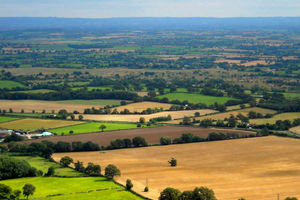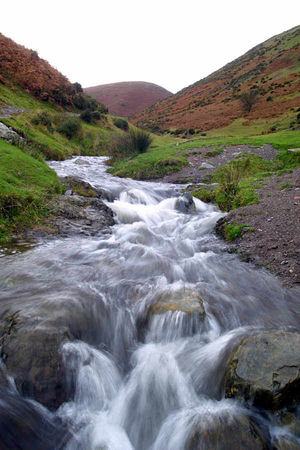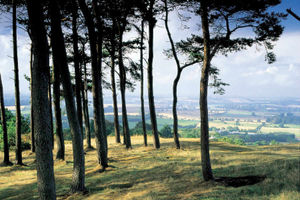Top 10 Midlands walks
With a number of Areas of Outstanding Beauty (AONB) in the region there are plenty of places to walk, whether you're a serious rambler or just want to enjoy a quiet stroll with the family. There are plenty of landmarks to see all over the West Midlands, why not check some out?

Cannock Chase - Medium
Cannock Chase is one of the smallest AONB and because of the proximity of large populated areas and rich mineral reserves is also one of the most threatened. 'The Chase' was once a medieval royal hunting forest and despite being so close to urban areas it remains surprisingly remote. Wild deer still roam the Chase and are a common sight when out walking. Much of the area including heathland, woodland and valley wetland habitats, are protected as Sites of Special Scientific Interest (SSSI). The heaths are the largest surviving example of this kind of environment in the Midlands and support some interesting species of wildlife including the nightjar, adders and lizards. The Chase is criss-crossed by many footpaths and bridleways to keep you occupied.
Malvern Hills – Easy/Medium/Hard
Located south of Worcester, the Malvern Hills includes parts of Worcestershire, Herefordshire and Gloucestershire. Despite its relatively small size there are a wide range of landscapes within the area and is classed as an AONB. The rolling hills and fields of Herefordshire are located to the West and the flatter plains of the Severn Valley to the East. Much of the drama and beauty of the Hills arise from the way they dramatically rise out of the landscape. Another feature to look out for are the many springs and fountains which flow from outlets all around them, so why not fill up your bottles while you're there. This walk is for all abilities whether you enjoy a gentle stroll along a tree-lined path or an energetic trek along the ridge of the Malvern Hills. The Scenery is breathtaking so remember to take your camera!
Bewdley to forest – Easy/Medium

Shropshire Hills – Easy/Medium/Hard
It consists of a number of areas of hills centered around Church Stretton. The Hills are known for the variety, extensive network of paths, and wonderful scenery. The most popular Hills are the Long Mynd but others including Wenlock Edge, the Stiperstones and those around Clun are also gaining in popularity. The Long Mynd is an AONB, and a SSSI. It is also one of the oldest and most important geological sites in the country. Down in Carding Mill Valley, near Church Stretton there are excellent visitor facilities where you can also play in the stream, relax with a picnic or head on an adventure in the hills. Whatever your preference, from a short amble to a good long stomp, the paths and open spaces of the Shropshire Hills will take you along river valleys, through pastures, meadows and ancient woodlands, around pretty villages, or over hilltops of rock and heather. Here you can follow the boundaries of the old Mercian kingdom, the footsteps of ancient traders and take in the views from Iron Age hillforts.
Dimmingsdale – Easy/Medium
Magnificent drives built by the Earl of Shrewsbury have been incorporated in the Valley walk. Visitors to this North Staffordshire beauty spot can stroll where fine carriages once carried gentry. The rolling hills and dramatic sandstone outcrops make a visit to this woodland a delight all year round. The terrain is steep in some places but low level strolls around the magnificent pools are popular with most. Spotted and green woodpeckers can sometimes be heard echoing through the valley, buzzards soar above it and pied flycatchers, redstarts and the willow warbler are also residents of this tranquil place. It is also home to tawny and little owls and many more common woodland birds. The trees also provide shelter and protection for a host of mammals as well as being the perfect habitat for wild flowers This hidden gem is affectionately known as 'Little Switzerland' and 'Fairy Glen' and has been described by a priest as being 'the closest place to heaven'. Some of the land is in private ownership and visitors are asked to respect this.
Sandwell Valley - Easy
An easy walk around an RSPB nature reserve and a fine country park reveals a legacy of agriculture and industry. Situated at the north eastern edge of West Bromwich, Sandwell Valley once was home to a 12th-century Benedictine monastery which stood upon the earlier hermitage. The park has become a major leisure facility, with three golf courses, walking routes, a Millennium Cycle Route and two off-road cycle paths which have been specially designed for mountain bikes. The RSPB have established a nature reserve here and throughout the year there are lapwings, grey herons, kingfishers, skylarks and goldfinches, while in the summer months, yellow wagtails, spotted flycatchers, tree pipits and even yellow-tip butterflies may make an appearance.
Walsall Waterfront - Easy

Clent Hill - Medium
A brief circuit of the most visited hills in Worcestershire where, in springtime, fields of rapeseed oil flood the landscape with gold. More people visit the Clent Hills than Worcester Cathedral with three car parks for ease of access. On a clear day it has some of the most breathtaking panoramic views of the Cotswolds, Shropshire Hills and Welsh borders. In late April or early May as well as the vertical grey blocks of the Birmingham city centre, horizontal yellow blocks of modern rural Worcestershire, created by the flowers of oilseed rape are visible. Look out for St Kenelm's Church in Romsley parish where there is supposedly a crypt containing a holy spring.
Kinver - Easy
Kinver is a short walk combining both curious cave dwellings with the best views in Staffordshire. Kinver Edge has tremendous views; however, the real interest lies below the summit, in small houses carved into the rock. Look out for Nanny's Rock, just inside the National Trust boundary, and just off the path, it provides a breathtaking viewpoint and a great place to sit and have a picnic to admire the view - it has a great collection of simple cave/rock dwellings carved out beneath, take considerable care to reach them as the ground is steep and rocky in places. The most impressive dwellings are at Holy Austin Rock, legend has it that it was named after a hermit who lived near the site. Visitors can see how occupants would have lived over 100 years ago, and may be surprised at just how cosy they feel. Holy Austin Rock has also been designated as a SSSI for its sandstone, which was formed from solidified sand dunes in the Permian era, 250 million years ago.
Sutton Park - Medium
Where the wild things are experience is a longer walk visiting the largest National Nature Reserve in the West Midlands. Sutton Park's wild and wooded countryside of moorland, meadows, lakes and groves, and is one of the largest urban parks in the country. English Nature has regarded this as a NNR in an effort to preserve its wonderful landscape. Although it is now surrounded by residential properties it remains an important area for Birmingham and the local Sutton Coldfield community. It's a valuable space offering a wide range of leisure pursuits whether it be joggers, kite-fliers, cyclists or walkers. However, it is possible to escape from the hustle and bustle of the surrounding towns/cities to find peace and quiet. Look out for Bracebridge Pool which is regarded by many as the most beautiful pool in the park. It was built for Sir Ralph Bracebridge in order to maintain a plentiful supply of fish.
To find more walks in the Black Country, Shropshire and Staffordshire check out the AA's guide to walks and bikes rides at www.theaa.com/walk-and-bike-ride or Walking Britain at www.walkingbritain.co.uk. The Ramblers amongst you may want to check out the Ramblers website at www.ramblers.org.uk/go-walking/find-a-walk.aspx
By Jody Ball





